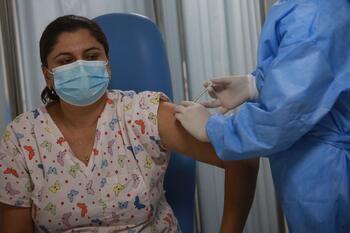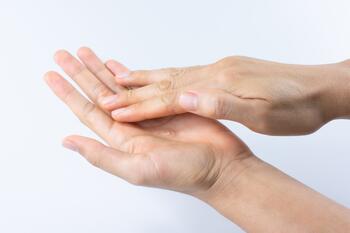COVID-19 FAQs
COVID-19, caused by the virus SARS-CoV-2 (severe acute respiratory syndrome coronavirus 2), continues to spread across the globe. It was first reported on December 1, 2020 and identified as a previously unknown betacoronavirus. The World Health Organization (WHO) formally declared COVID-19 to be a pandemic on 11 March 2020.
The evolution of SARS-CoV-2 has been characterised by the emergence of genetic mutations, which impact on transmissibility and disease severity. Viral mutations and variants are constantly monitored. Those which are considered to have concerning epidemiological, immunological or pathogenic properties, may be investigated and labelled ‘Variant of Concern’ (VOC).
Last updated on 19th July 2021
What are the symptoms of COVID-19?

The symptoms of COVID-19 range in severity from a mild common cold-like illness, to a severe viral pneumonia leading to acute respiratory distress syndrome, which may be potentially fatal. Key symptoms include fever, cough, breathing difficulties and loss of taste/smell. Other common symptoms include fatigue, sore throat, dizziness and head ache. Symptoms may be persistent and continue for more than 12 weeks in some patients, whereas some patients may be asymptomatic.
In people who have been double vaccinated but still become infected with SARS-CoV-2, the symptoms appear to be less severe. Find out more about your risk of COVID-19 after vaccination on the Zoe symptom study website:
Which patients are more likely to have severe symptoms?

• The median age of patients admitted to hospital was 73 years
• More men (60%) were admitted than women (40%)
The commonest comorbidities were chronic cardiac disease (31%), diabetes (21%) and non-asthmatic chronic pulmonary disease (18%). Obesity was also found to be a major additional risk factor [Docherty, 2020].
What is the impact of COVID-19 on children?

Children appear to have a lower susceptibility to infection compared with adults. Most cases in children are from within family groups, or found in children who have a history of close contact with an infected patient. It is rare for children to be the primary case in household transmission. [Zhu, 2020]
In the UK, a study found that children and young adults represented 0.9% of all hospitalised patients. The median age of children admitted to hospital was 4.6 years, 56% were male, 35% were under 12 months of age, and 42% had at least one comorbidity. [Swann, 2020]
In terms of ethnicity, 57% were White, 12% were South Asian, and 10% were Black. The key risk factors for a child to be admitted to the critical care unit were those under 1 month of age, those aged 10 to 14 years, and BAME groups [Swann, 2020].
What is known about SARS-CoV-2?

Severe acute respiratory syndrome coronavirus 2 (SARS-CoV-2) is a previously unknown betacoronavirus that was discovered in samples taken from clusters of patients who presented with pneumonia of unknown cause in Wuhan City, Hubei Province, China, in December 2019.
Coronaviruses are a large family of enveloped RNA viruses. RNA (ribonucleic acid) is the carrier of genetic information in coronaviruses. The RNA genetic material is covered by a protein capsule surrounded by an envelope of fat and protein molecules. Out of this envelope there may be protrusions which the virus will use to attach to the host cell. Coronaviruses have a ‘corona’ or crown of spikes on their surface, which helps them attach to cells.
Some enveloped RNA viruses cause illness in people e.g. common cold, severe acute respiratory syndrome [SARS] and Middle East respiratory syndrome [MERS]. Others circulate among mammals and birds, but occasionally spread to humans, as happened with SARS and MERS.
SARS-CoV-2 is the seventh coronavirus known to infect humans and is distinct from SARS-CoV and MERS-CoV. It is a zoonotic virus, meaning that it causes an infectious disease which may be transmitted between species from animals to humans (or from humans to animals). The virus appears to have some similarities to SARS-like coronaviruses identified in some bats.
Why do variants of SARS-CoV-2 exist?

All viruses, including SARS-CoV-2, mutate over time. Over 170,000 variants of the SARS-CoV-2 virus have been sequenced by the COVID-19 Genomics UK Consortium (COG-UK) as of 8 January 2021. COG-UK captures SARS-CoV-2 samples from infections across the UK and produces summaries on mutations.
In a 2020 global study of over 12,000 mutations of the SARS-CoV-2 virus (not including the recent Kent, South Africa and Brazil variants), there was no evidence to suggest that any of the identified SARS-CoV-2 variants were associated with significantly increased transmissibility [van Dorp, 2020]. However, data is constantly changing and there are three variants currently causing concern – the UK, South Africa and Brazil strains.
The UK variant VOC 202012/01 (B.1.1.7 lineage) was first identified in Kent, but its origin is unclear. It has been reported in more than 50 countries. There is a theoretical possibility that this variant may be more transmissible, but preliminary analyses also indicate that there is no change in disease severity [WHO, variants, 2020].
The South Africa variant VOC 202012/02 (B.1.351 lineage; 20C/501Y.V2)
has similar spike protein mutations to the UK variant. There is currently no evidence to suggest that this variant has any impact on disease transmission or severity, or mortality [WHO, variants, 2020]. Although its potential effects on vaccine efficacy are currently being studied.
The Brazil variant VOC 202101/02 (B.1.1.28.1 or P.1 lineage; 20J/501Y.V3) was first detected in Japan in four travellers from Brazil. The variant contains three mutations in the spike protein receptor-binding domain, which may affect its transmissibility.
Further investigations are required to more fully understand the impact of these three and other reported variants on transmissibility, disease severity and vaccine response.
The delta covid-19 variant (B.1.617.2), which was first detected in India, has overtaken the alpha variant, better known as the UK or Kent variant (B.1.1.7), to make it the most dominant strain currently circulating in the UK. There is some evidence that the risk of hospital admission is higher in people with the delta variant, although most of those admitted had not been vaccinated (Torjesen, I., 2021).
How is SARS-CoV-2 transmitted?

SARS-CoV-2 is a respiratory virus and like other respiratory viruses is transmitted in three main ways, through infected saliva and respiratory secretions. First, contact transmission, where someone comes into direct contact with an infected person or touches a surface that has been contaminated. Second, through virus containing droplet transmission; droplets are expelled when an infected person coughs, sneezes, talks, or sings [WHO, transmission, 2020]. Third, through airborne transmission of smaller viral particles that are suspended in the air over longer distances and time than droplet transmission.
Proximity to and the amount of time spent with an infected person, and how well ventilated the environment is, are key determinants of transmission risk [Meyerowitz , 2020].
Super spreading events (SSEs) have been reported, which are associated with widespread growth early in an outbreak and sustained transmission in later stages [Frieden, 2020]. Environments and settings at high risk for SSEs include closed environments such as healthcare facilities, nursing homes, prisons, homeless shelters, schools, and sites of mass gatherings [Frieden, 2020].
Transmission from contaminated surfaces may be possible. SARS-CoV-2 has been found to be stable on plastic and stainless steel for up to 72 hours, on copper for up to 4 hours and cardboard up to 24 hours under laboratory conditions [van Doremalen, 2020].
Hospital-acquired infections (defined as patients diagnosed more than 7 days after hospital admission) accounted for approximately 17% of COVID-19 infections in the NHS England as of 26 October 2020, and rates have been as high as 25% in some areas [Heneghan, 2020]..
What is the relationship between symptoms and transmission?

Transmission is mainly spread via droplets and close contact with infected symptomatic cases. Transmissibility depends on the amount of viable virus being shed and expelled by an infected person. The viral load is highest just before or around the time when symptoms appear and during the first 5-7 days of illness. Other factors affecting transmission are the type of environment and what infection prevention measures are in place [WHO, infection prevention, 2020].
Transmission may sometimes occur during the incubation period, usually 1 to 3 days before symptom onset [WHO, mask use, 2020]
People without symptoms may be pre-symptomatic, or they may remain persistently asymptomatic. Estimating the prevalence of asymptomatic cases in the population is difficult. A meta-analysis of over 50,000 people found that 15.6% of confirmed cases were asymptomatic at the time of testing and nearly half developed symptoms later [He, 2021]. The overall estimate of the proportion of people who become infected and remain asymptomatic throughout infection has been estimated to be between 17% to 33% [Buitrago-Garcia, 2020].
Are vaccines effective against COVID-19?

Vaccines which stimulate an immune response to SARS-CoV-2 are now available in many countries, including the UK, the US, Europe, Canada, China, and Russia.
Immunisation programmes generally prioritise people who are at highest risk from serious disease or death (e.g., residents and staff in care homes, older people, healthcare workers, and those with underlying health conditions).
It is currently unknown whether vaccines prevent asymptomatic infection or transmission from individuals who are infected despite vaccination.
In the UK, everyone over the age of 18 can book a Covid-19 vaccination. Although the Medicines and Healthcare products Regulatory Agency (MHRA), has approved the Pfizer/BioNTec COVID-19 vaccine for use among children aged 12 and over in the UK, the Joint Committee on Vaccination and Immunisation (JCVI) has not advised that under 18s should be vaccinated.
Most vaccines against viral infection are effective at preventing severe disease. They rely on weakened or inactivated parts of the virus to provoke an immune response in the recipient.
Sometimes, local and systemic reactions such as pain or fever can occur as part of the immune response. Usually, most reactions are mild and transient. Vaccines are formulated to produce the best possible immune response, whilst minimising reactions in the recipient.

A new vaccine against SARS-CoV-2 has been developed which is made using messenger ribonucleic acid (also known as messenger RNA or mRNA). Whereas DNA is where genetic information is stored, mRNA - as its name suggests - transmits information and helps to determine how genes are expressed. mRNA essentially puts DNA instructions into action.
A form of mRNA has been synthesised to cause cells to make a viral protein from the Covid-19 coronavirus. The protein is harmless in isolation, but prompts the human immune system to make antibodies and immune cells that can recognise the protein quickly to protect the vaccinated individual during future exposures to the disease.
Vaccines cannot be 100% effective as some people fail to produce an adequate immune response to the vaccine and immunity may diminish over time. The seasonal influenza vaccine is formulated slightly differently each year as the virus slightly mutates, leading to new strains.
Is hand hygiene in healthcare settings effective against COVID-19?

The spread of COVID-19 in hospital settings is facilitated by the presence of high viral loads in the respiratory tract of hospitalised infected patients, released into the environment through droplets spread via coughing or sneezing [Rothan, 2020]. In closed and stagnant environments such as hospital wards, droplets can remain suspended for several minutes and cover long distances, potentially maintaining their ability to transmit disease [Bourouiba, 2020; Ong, 2020].
The stability of SARS- CoV-2 on human skin has recently been evaluated under laboratory conditions and was found to be approximately 9 hours [Hirose, 2020].
This long survival time may increase the risk of viral invasion in the body or its transmission from the skin to other surfaces or people, with a potential impact on the acceleration of the SARS-CoV-2 pandemic. However, when exposed to an ethanol-based disinfectant, the researchers found the SARS-CoV-2 virus on human skin was completely inactivated within 15 seconds [Hirose, 2020].

An ABHR for use in hospitals should conform to the stringent testing governed by for example European Norm (EN): EN 1500, EN 12791 and EN 14476.
View full references
References
Bourouiba L. Turbulent gas clouds and respiratory pathogen emissions: potential implications for reducing transmission of COVID-19. JAMA - J. Am. Med. Assoc. 2020;323:1837–1838
Buitrago-Garcia D, Egli-Gany D, Counotte MJ, et al. Occurrence and transmission potential of asymptomatic and presymptomatic SARS-CoV-2 infections: a living systematic review and meta-analysis. PLoS Med. 2020 Sep;17(9):e1003346
Centers for Disease Control and Prevention. How COVID-19 spreads. 2020 [internet publication].
Department of Health & Social Care. Joint Committee on Vaccination and Immunisation: advice on priority groups for COVID-19 vaccination, 30 December 2020. 2021 [internet publication]
Docherty AB, Harrison EM, Green CA, et al. Features of 20 133 UK patients in hospital with covid-19 using the ISARIC WHO clinical characterisation protocol: prospective observational cohort study. BMJ. 2020 May 22;369:m1985.
van Doremalen N, Bushmaker T, Morris DH, et al. Aerosol and surface stability of SARS-CoV-2 as compared with SARS-CoV-1. N Engl J Med. 2020 Apr 16;382(16):1564-7.
van Dorp L, Richard D, Tan CCS, et al. No evidence for increased transmissibility from recurrent mutations in SARS-CoV-2. Nat Commun. 2020 Nov 25;11(1):5986
Frieden TR, Lee CT. Identifying and interrupting superspreading events: implications for control of severe acute respiratory syndrome coronavirus 2. Emerg Infect Dis. 2020 Jun;26(6):1059-66
He J, Guo Y, Mao R, et al. Proportion of asymptomatic coronavirus disease 2019 (COVID-19): a systematic review and meta-analysis. J Med Virol. 2021 Feb;93(2):820-30.
Hirose R et al, Survival of SARS-CoV-2 and influenza virus on the human skin: Importance of hand hygiene in COVID-19, Clinical Infectious Diseases, 2020
Heneghan C, Howdon D, Oke J, et al. Centre for Evidence-Based Medicine; The ongoing problem of UK hospital acquired infections. 2020 [internet publication]. https://www.cebm.net/covid-19/the-ongoing-problem-of-hospital-acquired-infections-across-the-uk/
Meyerowitz EA, Richterman A, Gandhi RT, et al. Transmission of SARS-CoV-2: a review of viral, host, and environmental factors. Ann Intern Med. 2020 Sep 17 [Epub ahead of print].
Ong S et al .Air, surface environmental, and personal protective equipment contamination by severe acute respiratory syndrome coronavirus 2 (SARS-CoV-2) from a symptomatic patient. JAM. 2020;323
Rothan H.A. et al. The epidemiology and pathogenesis of coronavirus disease (COVID-19) outbreak. J. Autoimmun. 2020
Swann OV, Holden KA, Turtle L, et al. Clinical characteristics of children and young people admitted to hospital with covid-19 in United Kingdom: prospective multicentre observational cohort study. BMJ. 2020 Aug 27;370:m3249
Torjesen, I., 2021, Ingrid Torjesen, Covid-19: Delta variant is now UK’s most dominant strain and spreading through schools, 373 doi: https://doi.org/10.1136/bmj.n1445 (Published 04 June 2021), BMJ 2021;373:n1445
World Health Organization. SARS-CoV-2 variants. 2020 [internet publication].
World Health Organization. Transmission of SARS-CoV-2: implications for infection prevention precautions – scientific brief. 2020 [internet publication
World Health Organization. Mask use in the context of COVID-19: interim guidance. 2020 [internet publication]
Zhu Y, Bloxham CJ, Hulme KD, et al. A meta-analysis on the role of children in SARS-CoV-2 in household transmission clusters. Clin Infect Dis. 2020 Dec 6 [Epub ahead of print]es dignissim, justo. Mauris gravida dui eget elit.






















